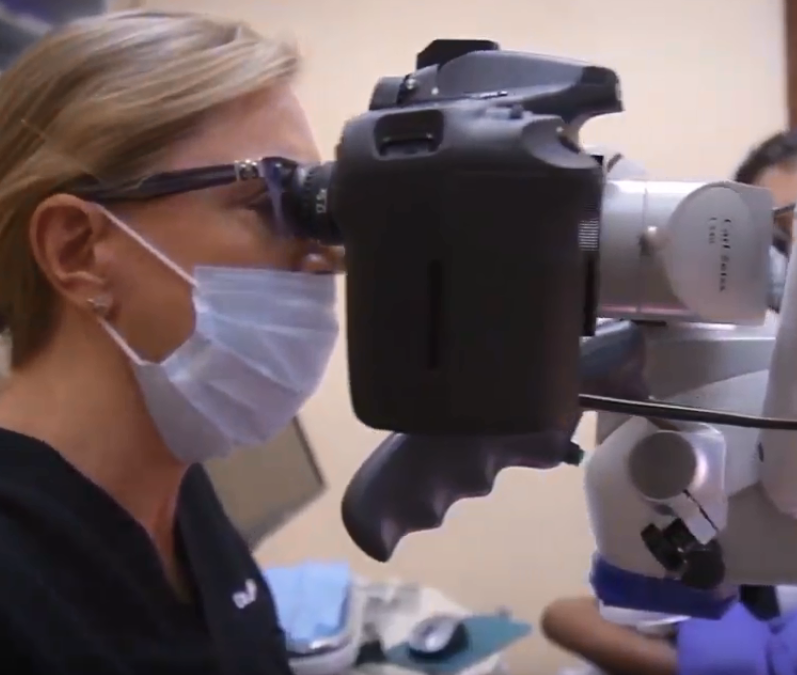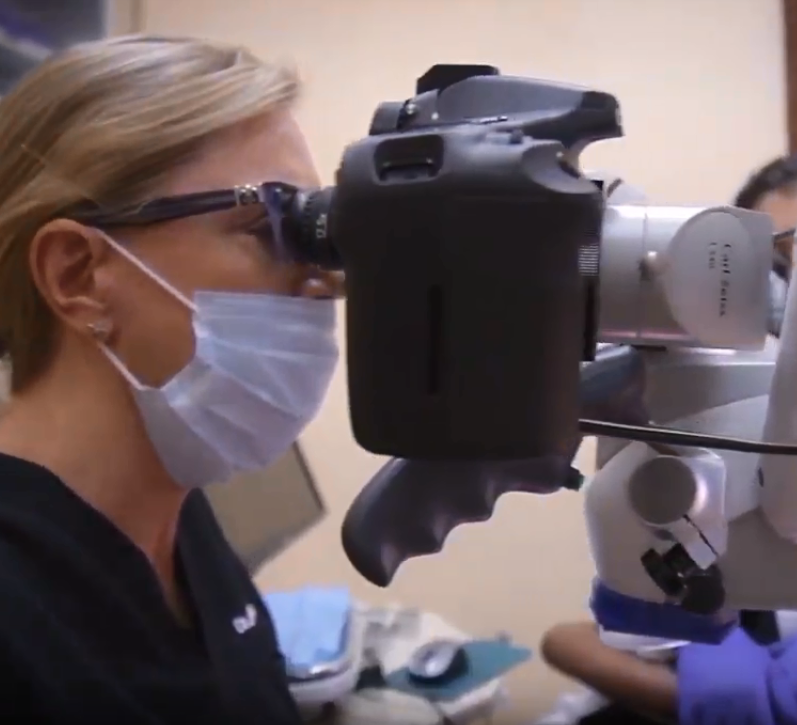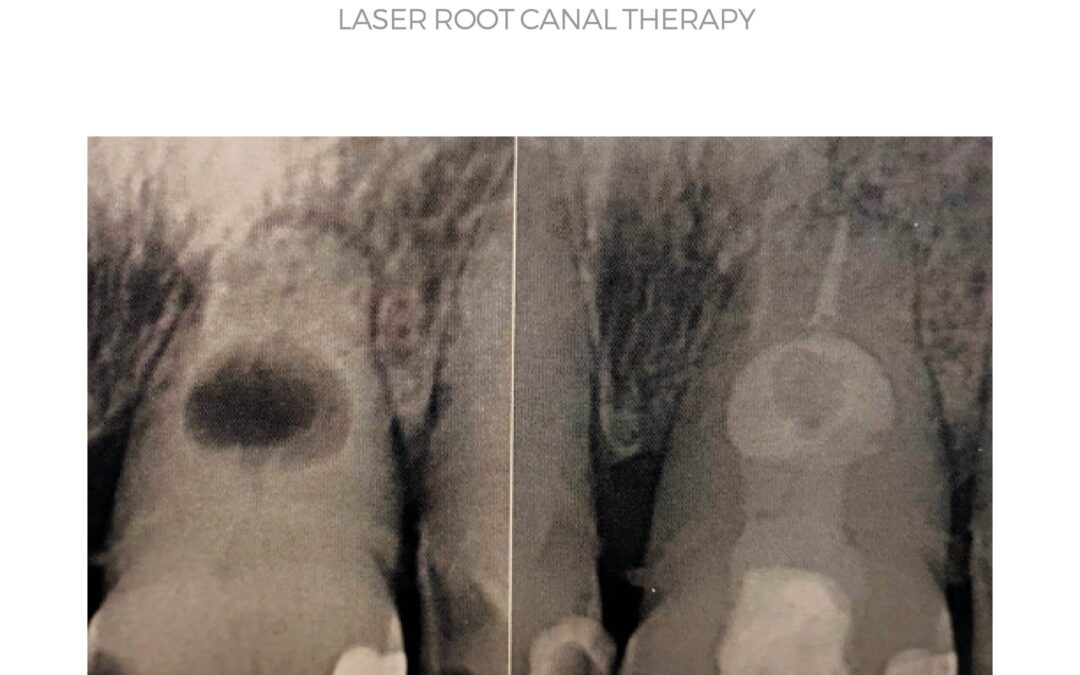
by Dr. Jacqueline S. Allen | Dec 20, 2022 | Blog, Endodontics, Endodontist, Root Canal
More than 41,000 root canal treatments are performed each day in the United States – more than 15 million each year. Threats to your natural teeth leading to a root canal are not complicated, but each person’s experience of their symptoms can be unique.
Let’s look at some of the causes and symptoms of tooth infections that can result in a root canal. If you experience any of these symptoms, contact your dentist or endodontist immediately to schedule an examination.

The Two D’s Of Tooth Root Infection
Root canal treatment has proven to be one of the most effective ways to deal with infection in the pulp of the tooth. The infection is usually related to two major culprits: damage to the tooth structure that lets in bacteria, or advanced decay reaching the interior areas of the tooth. Such an infection might show in a variety of symptoms.
Symptoms Indicating A Root Canal Is Needed
1. Persistent pain in a tooth. A healthy tooth does not hurt. While tooth pain can require other treatments beyond or in addition to a root canal, constant or recurring tooth pain should definitely prompt a visit to your dental provider.
2. A pimple or “gum boil” near the infected tooth. Dying tissues in the tooth can cause a buildup of fluid under the gum surface. If the boil bursts, the fluid will have an unpleasant taste and odor.
3. Swollen gums near the infected tooth. Your gums may feel tender or look swollen, even if there is no gum boil present. This swelling can be intermittent, so you may not be in the clear even if the swelling goes away for a while.
4. Sensitivity to sources of heat and cold. An infected tooth can feel pain or sensitivity to hot or cold food and drink, even long after you’ve consumed it. The sensation can be anything from a sharp pain to a dull ache.
5. Your tooth feels loose when you touch it. The tooth infection can seep acidic wastes that soften the bone around the tooth needing a root canal, making it feel loose inside your mouth.
6. The tooth is discolored. The roots of a badly infected tooth may be receiving a poor supply of blood, which can make it look darker than usual.
Clearly, it’s difficult to know if you need a root canal without a thorough dental examination. If you have one or more of these symptoms, make an appointment now to get an official diagnosis.
“Symptoms of dental issues requiring a root canal can be highly individualized,” says Dr. Jacqueline Allen, Phoenix Endodontic Group. “Our endodontists will evaluate your symptoms and plan your treatment so you can save your tooth and stop hurting.”

by Dr. Jacqueline S. Allen | Nov 21, 2022 | Blog, Endodontics, Endodontist, Phoenix Endodontic Group, Root Canal
It can be a shock to learn you require root canal therapy to address an injured or infected tooth. If you’ve never been to an endodontist, or don’t have any friends or family who’ve had a root canal, you may naturally have a lot of questions about what to expect.
Understanding the details of root canal therapy can help you come to your first appointment better prepared. Here is a brief overview of the main stages of a root canal.
 The Key Stages Of Root Canal Therapy
The Key Stages Of Root Canal Therapy
-
Confirmation of diagnosis. Your endodontist will confirm your diagnosis when you arrive for your first root canal therapy appointment by reviewing your X-rays and performing a visual inspection of your tooth.
-
Local anesthesia and dental dam placement. The endodontist will numb the area around your tooth with a local anesthetic. They will also place a rubber sheet known as a dental dam around the tooth to keep it clean and dry while they work.
-
Creating an access hole. After the tooth has been prepared and your gums numbed, an access hole will be drilled in the crown of the tooth to allow the dental pulp to be removed.
-
Pulp removal, filing, and cleaning. Once the access hole is created, the endodontist removes the infected tooth pulp, using special instruments to reshape the tooth’s canals and ensure all infected material is gone. Then the inner tooth is treated with antimicrobial washes to remove debris and aid healing.
-
Filling the root canals. This is the step that gives root canal therapy its name. A biocompatible material, usually gutta-percha, is used to fill the canals and prevent future infections.
-
Placement of temporary filling. The first part of the root canal procedure concludes with a temporary filling on your tooth to ensure the tooth heals and bacteria is not re-introduced while your permanent restoration is being fabricated.
-
Placement of permanent filling and crown. Your root canal therapy is not considered complete until a permanent filling is placed on your tooth, AND the tooth is capped with a crown. A crown provides extra protection against infection and shores up the structural integrity of your natural tooth.
“Patients are surprised sometimes to find out that root canal therapy follows a simple, straightforward process,” says Dr. Jacqueline S. Allen, who practices at Phoenix Endodontic Group. “But our profession’s approach to this procedure has been developed and refined for more than 150 years. We’re happy to explain each step in detail, and to address any concerns or questions you may have, every step of the way. We want each of our patients to be comfortable and confident.”
by Dr. Jacqueline S. Allen | Oct 21, 2022 | Blog, Endodontics, Endodontist, Root Canal, Vital Pulp Therapy (VPT)
While endodontists excel at performing root canal therapy on teeth compromised by injury or infection, they also have other effective techniques for saving natural teeth. One procedure that can provide excellent results is vital pulp therapy, or VPT. Once considered something that could only be performed on younger patients with still-developing adult teeth, today VPT has been proven even more broadly effective when patients meet a select set of circumstances related to the state of their pulp — the mass of blood vessels, nerves and connective tissues that represent the living center of a tooth.
How Vital Pulp Therapy Works To Preserve Natural Teeth
There are three main versions of VPT. Endodontists determine which one has the greatest chance of success by a careful examination of a patient’s tooth and of the decay or infection present in the pulp.
-
Direct capping of the pulp is most often used in immature adult teeth or in teeth that do not show evidence of irreversible pulp inflammation. This approach calls for the removal of all the infected pulp, followed by irrigation of the affected area with a solution of 17 percent ethylenediaminetetraacetic acid (EDTA). Once the area from which the pulp was removed has been capped with a bioceramic material, the healing can begin.
-
Indirect capping is a technique that is similar to direct capping, but in this case, some or all of the infected pulp is left in place to avoid direct exposure of the pulp during examination or the capping process itself. A cap is placed over the infected pulp to stop the infection from spreading and to promote reparative dentin development in the tooth.
-
Pulpotomies are yet another type of vital pulp therapy. They are performed by removal of infected pulp down to healthy coronal tissue, or even into the canals of the tooth if necessary. Medicines may be applied to address the inflammation and the infection. As with the previous two treatments, the area is capped with a biocompatible ceramic restoration. A light-cured glass ionomer may be added above the cap to ensure the solution for saving the tooth is permanent and leak proof.
“Vital pulp therapy offers another opportunity for endodontists to preserve natural teeth — in some cases, the pulp itself can be preserved,” says Dr. Allen, who practices with the Phoenix Endodontic Group. “Our specialty is constantly evaluating therapeutic techniques like VPT for their efficacy in saving teeth over the long term.”

by Dr. Jacqueline S. Allen | Aug 19, 2022 | Blog, Endodontics, Endodontist, Phoenix Endodontic Group, Root Canal
Patients often ask our staff at Phoenix Endodontic Group questions about their root canals looking to better understand what they will experience. Many people are concerned about the severity of the procedure or how much recovery time to plan for.
The good news is that many root canals have a quick recovery time – often just a week of special post-operative care. Many factors can impact your individual outcome, though, so it is important to understand the circumstances that brought you to the endodontist in the first place. Here’s a short list of some situations that can make the root canal procedure itself or your post-op period require extra care to ensure the root canal is successful.
 What Makes A Root Canal A Serious Procedure?
What Makes A Root Canal A Serious Procedure?
-
When there is pre-existing infection or tooth damage. A crack or chip can let infection deep into a tooth’s pulp. Extensive tooth decay can also reach the pulp. If the infection causes an abscess, antibiotics may be needed first to eliminate the bacteria so the root canal can safely seal the roots so infection does not happen again.
-
When the tooth involved has multiple roots. The level of complexity involved with cleaning and sealing canals during a root canal increases with the number of canals in the tooth receiving treatment. Molars have up to four canals; premolars have one or two; canines and incisors have just a single canal.
-
When you don’t contact your endodontist if you have aftercare problems. An ordinary root canal can escalate quickly to challenging if you do not promptly call your endodontist when you experience pain that is severe or rapidly increasing; if the temporary filling placed in the tooth comes out; or if you can see swelling inside or outside of your mouth.
-
When you don’t return for your permanent crown as scheduled. The tooth being treated with a root canal should receive a permanent crown about two weeks after the procedure. Crowns provide structural support, protect the tooth from infection, and reduce nerve sensitivity to hot or cold foods and beverages. Not getting a permanent crown leaves your tooth vulnerable to further damage or infection and possible the failure of the root canal.
“The seriousness of each root canal is impacted by a patient’s individual oral health,” says Dr. Allen, of the Phoenix Endodontic Group. “We are happy to explain our assessment of your situation and provide tips for making your root canal successful and stress-free, so it can help you hold on to your natural tooth for the rest of your life.”

by Dr. Jacqueline S. Allen | Jul 20, 2022 | Blog, Endodontics, Endodontist, Phoenix Endodontic Group, Root Canal
Popular culture often associates lasers with science-fiction weapons or real-life space exploration, but the technology can also be used inside the human body. At the Phoenix Endodontic Group, our endodontists frequently use laser-based tools to assist in root canal treatments.
The practice uses laser technology manufactured by Fontana (SSP and SWEEPS®) and Biolase (Waterlase) at its Phoenix office location. Both brands of tools provide extra assistance in the critical phases of cleaning and disinfecting tooth roots during a root canal treatment.
 Lasers Bring Benefits During A Root Canal Treatment
Lasers Bring Benefits During A Root Canal Treatment
-
The laser can provide initial cleaning in the coronal (crown) area of the tooth. An endodontist will begin a root canal by creating an opening in the crown. The laser can be used in this area of the tooth to remove calcifications and biological debris.
-
The laser can assist cleaning of the root canals. After a canal has been prepared using files or other tools, the endodontist may flood the canal with water and activate the laser while withdrawing the water from the space. The laser creates vapor bubbles, which collapse to form microbubbles and a pressure wave; these phenomena are what clean biofilm from the canals.
-
Laser treatment can also help disinfect the canals as they are being irrigated. Once the endodontist shapes the canals with their files, they will irrigate them with disinfecting liquids. Lasers can be used at this point to augment the disinfection process, with the pressure wave created by the vapor bubbles pushing the disinfectant deep into the canal recesses and generally making the process more effective than the traditional disinfecting step by itself.
-
Finally, lasers can be used to remove the chemical disinfectants prior to filling the canals. After the canals have been cleansed, shaped and disinfected, the laser tool can be used to remove the disinfecting liquid in the canals by activating it for about 30 seconds to vaporize any remaining liquid.
According to Dr. Jacqueline S. Allen, who practices at the Phoenix Endodontic Group, “One significant advantage to using lasers during root canals is that they can provide a more thorough removal of bacteria, debris and other materials without the risk of apical (tooth root area) extrusion.” She continues, “We are happy to explain to patients how we use Fontana and Biolase laser technology to enhance the safety and effectiveness of their root canal treatments.”

by Dr. Jacqueline S. Allen | Jun 22, 2022 | Blog, Endodontics, Endodontist, Phoenix Endodontic Group, Root Canal
Fixing a cracked tooth can be like figuring out the damage after a car accident. If you don’t have a professional check things out, what looks like a surface dent can actually turn out to be really serious. Since dental bone does not behave like other types of bone and cannot knit itself back together, a chip or a crack to the tooth is likely to get worse over time.
In the case of a cracked tooth, your repair expert is an endodontist. Endodontists are experts in saving natural teeth. They frequently see clients with a cracked tooth, and can use their dental specialty training to determine if additional intervention such as a root canal is needed before placing a crown on the tooth.
 When Does A Cracked Tooth Need A Root Canal Before A Crown?
When Does A Cracked Tooth Need A Root Canal Before A Crown?
The main job of a dental crown is to provide structural support by acting as the new outer surface of a tooth. Before a crown is cemented into place, your endodontist will want to make sure the natural tooth underneath the crown is as healthy as possible. If there is any injury or infection in a tooth’s nerve pulp, a root canal can provide a healthy tooth underneath.
With a crack deep enough to damage the root pulp, a root canal will be needed to prevent further difficulty, possibly extraction. It can be difficult to tell from symptoms alone if you need a root canal before you get a crown placed on your cracked tooth. Some cracked teeth that need a root canal before the crown hurt a lot; some do not. Some teeth with large cracks do not have root/nerve damage, but some teeth with much smaller cracks may have infected nerve pulp that must be removed via a root canal.
It’s important to see your endodontist right away because there are some types of cracked tooth injuries that cannot be remedied with a root canal and a crown. If the crack in the tooth extends below the gum line, it’s highly likely that the tooth will need to be extracted.
“It’s vital to have an endodontist perform a careful evaluation of a cracked tooth – what you can see on the surface may not be an accurate picture of the entire situation,” says Dr. Allen, who practices with the Phoenix Endodontic Group. “Our office can perform the diagnostic procedures needed to determine if a root canal is called for before a crown is placed on the tooth.”




 The Key Stages Of Root Canal Therapy
The Key Stages Of Root Canal Therapy


